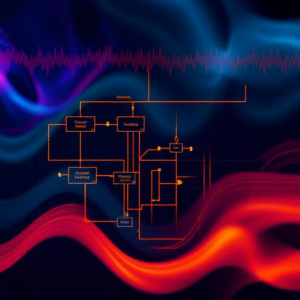Signal Flow Graphs – Explained
A Signal Flow Graph (SFG) is a graphical way to represent a system and how different parts of it are connected. It’s a tool used in control systems and signal processing to analyze and solve complex systems that involve multiple components or variables. In control systems and signal processing, Signal Flow Graphs are powerful tools to break down and solve complex systems by showing how signals interact and change as they pass through different components. In short, they are like roadmaps that guide us in understanding how a system works

What is a Signal Flow Graph (SFG)?
A Signal Flow Graph is like a map for a system where:
- Nodes (circles) represent system variables or signals.
- Edges (arrows) represent the relationship or flow of signals between the nodes.
- Each arrow can have a gain (a number that tells how much the signal gets amplified or reduced along the way).
In short, it’s a way to visually show how different parts of a system are connected and how the signals move through those parts.
Basic Components of a Signal Flow Graph
- Nodes (or Variables): These represent different signals or variables in the system. For example, it could be the output of a system, like the temperature in a room controlled by a thermostat.
- Edges (or Arrows): These represent the flow of signals between the nodes. The direction of the arrow shows which node is sending the signal to which node.
- Gain: Each edge (arrow) can have a number associated with it, which shows how much the signal gets amplified or changed as it moves along the path.
How Does a Signal Flow Graph Work?
Think of a Signal Flow Graph as a map of how signals travel through a system, like the flow of electricity through different parts of a circuit.
- Signals start at one node and travel along the edges (arrows) to other nodes.
- The edges might have a gain or coefficient that tells us how the signal will change as it moves.
- If there’s a feedback loop (a signal going back to an earlier point), it’s shown in the graph too.
Example: Simple Signal Flow Graph
Imagine you have a simple system with two components:
- Input Signal: Let’s say this is a temperature setting.
- System: This could be a heater that is controlled based on the input temperature.
- Output Signal: This could be the actual temperature of the room.
The flow graph might look like this:
- You have a node for the input (temperature setting).
- This signal flows through an arrow to the heater node, where it gets modified (amplified or adjusted) by some gain (like how fast the heater works).
- The modified signal then affects the room temperature (output node).
Here, the arrows represent how the input signal is processed by the system and results in an output.
Why Use Signal Flow Graphs?
Signal Flow Graphs are helpful because they make it easier to:
- Visualize the system: By looking at the graph, you can immediately see how signals flow and how the system works.
- Analyze complex systems: Instead of working with complicated equations, you can use the graph to track signals and understand how different parts of the system interact.
- Simplify calculations: Signal Flow Graphs help you find the relationship between input and output, making it easier to calculate things like system stability and performance.
Applications of Signal Flow Graphs
- Control Systems: In control systems, Signal Flow Graphs are used to analyze how signals flow through controllers, sensors, and actuators.
- Electrical Circuits: They are also used in electrical engineering to represent how current or voltage flows through different parts of a circuit.
- Communication Systems: In communication systems, these graphs help represent how signals move from the transmitter to the receiver.
Example: Simple Signal Flow Graph in Control Systems
Let’s look at an example of a feedback system:
- You have a controller that sends a signal to the plant (the system that does something, like a motor or heating system).
- The output from the plant is then measured and sent back as feedback to the controller.
This feedback loop is shown in a Signal Flow Graph as:
- The controller node sends a signal to the plant node.
- The plant output flows back to the controller, showing that it uses the feedback to adjust the system.
Tags: Communication Systems, complex system analysis, control system design, Control Systems, electrical circuit analysis, feedback control, Feedback Loop, feedback signal, flow graph components, flow graph examples, Gain, graphical analysis, input-output relationship, nodes and edges, SFG, Signal amplification, Signal flow, signal flow graph, Signal Flow Graphs, signal interactions, signal mapping, signal path, Signal Processing, system modeling, system performance, system representation, system stability, system variables, system visualization, transfer function


